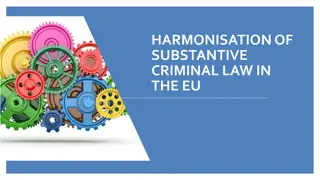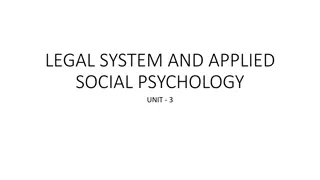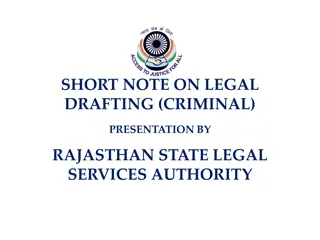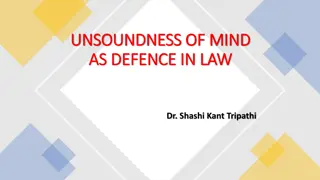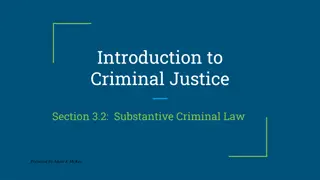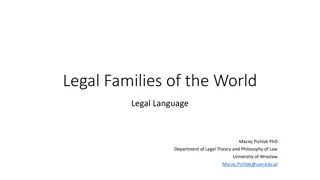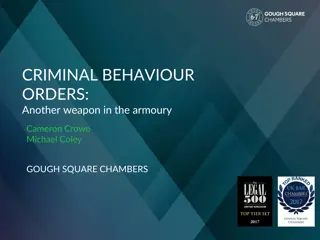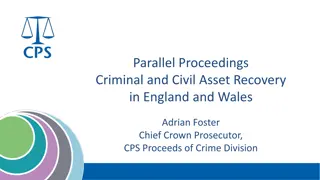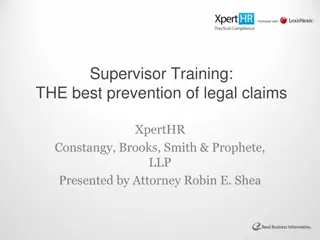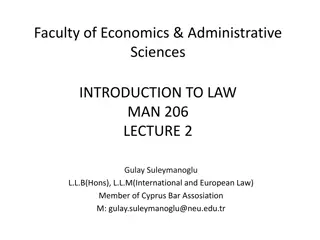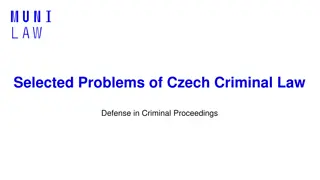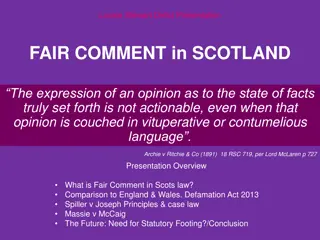Legal Defense of Loss of Control in Criminal Law
In the case of W stabbing her husband after a quarrel, explore the availability of the defense of loss of control. Understand the guidelines, rules, and elements of this defense, including the relevant authorities and ambiguities. Delve into the statutory and common law roots of the defense, focusing on elements like loss of control, qualifying trigger, and the objective test. Discover how these elements are considered in determining the applicability of the defense.
Download Presentation

Please find below an Image/Link to download the presentation.
The content on the website is provided AS IS for your information and personal use only. It may not be sold, licensed, or shared on other websites without obtaining consent from the author.If you encounter any issues during the download, it is possible that the publisher has removed the file from their server.
You are allowed to download the files provided on this website for personal or commercial use, subject to the condition that they are used lawfully. All files are the property of their respective owners.
The content on the website is provided AS IS for your information and personal use only. It may not be sold, licensed, or shared on other websites without obtaining consent from the author.
E N D
Presentation Transcript
Exercise -- Criminal Law W stabbed her husband H once through the heart with a kitchen knife after a quarrel in which H had called her a whore . At the time of the stabbing, H was asleep. They had had many similar quarrels during their 3 year marriage. H had often physically beaten W, who was, at the time of the killing, being treated for depression. Is the defence of loss of control available to W?
Guidelines Law/Rule What is the Rule? What is the authority for the applicable rule? What are alternative authorities? (ie the ambiguities in deciding whether the particular rule is applicable?) What are the elements of the rule? Are there ambiguities in the elements of the rule?
What is the authority for the Rule? In this section we check whether the rule is statutory or rooted in the common law. It may be necessary to give a legislative history or to refer to the evolution of the law.
What is the authority for the Rule? In this section we check whether the rule is statutory or rooted in the common law. It may be necessary to give a legislative history or to refer to the evolution of the law. Sample answer (Description of law from Homicide: Murder and Manslaughter -- https://www.cps.gov.uk/legal- guidance/homicide-murder-and-manslaughter) Defence is described in sections 54 and 55 Coroners and Justice Act 2009 Replaces common law defence and it is not considered necessary to refer to provocation case law However, new case law has arisen to clarify the elements
What are the elements? You can give a quick overview of the elements as a roadmap. This will help guide your answer, and will be especially useful if you start to run out of time. Notice that we are still at the top level here.
What are the elements? You can give a quick overview of the elements as a roadmap. This will help guide your answer, and will be especially useful if you start to run out of time. Notice that we are still at the top level here. Sample answer The loss of control defence has three components in Section 54(1)(a)(b) and (c) Coroners and Justice Act 2009: Loss of control (the first component), A qualifying trigger (the second component), and An objective test (the third component) - A person of D's sex and age, with a normal degree of tolerance and self-restraint and in the circumstances of D, might have reacted in the same or in a similar way to D.
How are the elements to be considered? Are the elements sequential or holistic? In general, elements are holistic and you should consider all of them. It is best to do this even if the statute says otherwise.
How are the elements to be considered? Are the elements sequential or holistic? In general, elements are holistic and you should consider all of them. It is best to do this even if the statute says otherwise. Sample answer The guidance on Loss of Control provides that the trial judge should consider the three components sequentially. Thus, in R v Dawes, Hatter and Bowyer [2013] EWCA Crim 322, since element 1 failed, the court did not consider the other elements. However, in R v Christian[2018] EWCA Crim 1344, the judge used a holistic approach which the Court of Appeal upheld.
Element 1: Loss of Control In this example, each element is a sub-issue. We can decide whether to do a separate IRAC. Here, we will take the holistic approach and do all of the rules first and then the application. For each element we ask: What is the Rule here? Statutory? Common law? Evolution? Law Reform? Any sub-elements?
Element 1: Loss of Control What is the Rule here? Statutory? Common law? Evolution? Law Reform? Any sub-elements? The court must consider whether sufficient evidence exists to show that there was actually a loss of control. In R v Dawes, for example, there was not. It does not matter whether or not the loss of control was sudden. The partial defence could still be put before a jury even where there has been delay between the trigger incident and the killing. However, it must be determined whether the time delay was sufficiently substantial to render the defence of loss of control untenable
Element 1: Drilling down This element of loss of control could be further explained. Decide if it is necessary by taking a look back at the facts. This is NOT the Application section and you will not expressly refer to the facts. However, you should still be guided by the scenario. We notice, for example, that the business of the cooling down period should attract more of our attention. The case Ahluwalia was one which led to the reform in law which saw the abolition of the provocation defence in England. A woman who killed her abusive husband was found to have had a cooling off period, rather than a boiling over period. ...
Element 2: Qualifying trigger What is the Rule here? Statutory? Common law? Evolution? Law Reform? Any sub-elements? Qualifying trigger must be meaningful. Does not include fear of violence unless the circumstances are extremely grave D must have justifiable sense that he has been seriously wronged R v Clinton [2012] EWCA Crim 2. D must not have caused the situation by inciting or manufacturing the situation Sexual infidelity cannot by itself qualify as a trigger.
Element 2: Drilling down Each of these four can be further explained. Decide if it is necessary by taking a look back at the facts. This is NOT the Application section and you will not expressly refer to the facts. However, you should still be guided by the scenario. Nothing in the scenario really requires that the trigger be discussed further. For example, on the topic of sexual infidelity, you can quote from Clinton:
Sexual Infidelity? We immediately acknowledge that the exclusion of sexual infidelity as a potential qualifying trigger is consistent with the concept of the autonomy of each individual. Of course, whatever the position may have been in times past, it is now clearly understood, and in the present context the law underlines, that no one (male or female) owns or possesses his or her spouse or partner. Nevertheless daily experience in both criminal and family courts demonstrates that the breakdown of relationships, whenever they occur, and for whatever reason, is always fraught with tension and difficulty, with the possibility of misunderstanding and the potential for apparently irrational fury. Meanwhile experience over many generations has shown that, however it may become apparent, when it does, sexual infidelity has the potential to create a highly emotional situation or to exacerbate a fraught situation, and to produce a completely unpredictable, and sometimes violent response. This may have nothing to do with any notional "rights" that the one may believe that he or she has over the other, and often stems from a sense of betrayal and heartbreak, and crushed dreams.
But what is it? Mr Birnbaumdrew attention to and adopted much of the illuminating and critical commentary by Professor Ormerod at pp.520-522 in Smith and Hogan's Criminal Law. To begin with, there is no definition of "sexual infidelity". Who and what is embraced in this concept? Is sexual infidelity to be construed narrowly so as to refer only to conduct which is related directly and exclusively to sexual activity? Only the words and acts constituting sexual activity are to be disregarded: on one construction, therefore, the effects are not. What acts relating to infidelity, but distinguishable from it on the basis that they are not "sexual", may be taken into account? Is the provision directly concerned with sexual infidelity, or with envy and jealousy and possessiveness, the sort of obsession that leads to violence against the victim on the basis expressed in the sadly familiar language, "if I cannot have him/her, then no one else will/can"? The notion of infidelity appears to involve a relationship between the two people to which one party may be unfaithful. Is a one- night-stand sufficient for this purpose?
Potential Exam Question? We considered the example of the wife who has been physically abused over a long period, and whose loss of self control was attributable to yet another beating by her husband, but also, for the first time, during the final beating, taunts of his sexual activities with another woman or other women. And so, after putting up with years of violent ill-treatment, what in reality finally caused the defendant's loss of control was hurtful language boasting of his sexual infidelity. Those words were the final straw. Mr Edis invited us to consider (he did not support the contention) whether, on a narrow interpretation of the statutory structure, if evidence to that effect were elicited (as it might, in cross-examination), there would then be no sufficient qualifying trigger at all. Although the persistent beating might in a different case fall within the provisions for qualifying triggers in section 55(4)(a) and (b), in the case we are considering, the wife had endured the violence and would have continued to endure it but for the sudden discovery of her husband's infidelity. On this basis the earlier history of violence, as well as the violence on the instant occasion, would not, without reference to the claims of sexual infidelity, carry sufficient weight to constitute a qualifying trigger. Yet in the real world the husband's conduct over the years, and the impact of what he said on the particular occasion when he was killed, should surely be considered as a whole. ... What about words? In Clinton, the wife said she had had sex with five men. If it was untrue, was it still infidelity?
Element 3: Objective Test What is the Rule here? Statutory? Common law? Evolution? Law Reform? Any sub-elements? A person of D's sex and age, with a normal degree of tolerance and self-restraint and in the circumstances of D, might have reacted in the same or in a similar way to D. Whether the circumstances were extremely grave and the defendant's sense of being seriously wronged by them was justifiable are matters that require objective assessment - R v Dawes [2013] EWCA Crim 322. Note that a mental disorder may be relevant to the qualifying trigger, but not to Element 3.
Element 3: Drilling down This can be further explained. Decide if it is necessary by taking a look back at the facts. This is NOT the Application section and you will not expressly refer to the facts. However, you should still be guided by the scenario An example of the objective test was seen in R v Christian. Mr Christian killed two people and injured two others, one seriously. He had stabbed one of the deceased victims in the back five times. He claimed provocation. Although there was evidence to support the existence of both a loss of control and a qualifying trigger, the judge ruled that D's reaction was so extreme and so protracted that no jury properly directed could conclude that the notional reasonable person might have reacted or behaved in the same or a similar way.
Application Does W display all three components to qualify for the loss of control defence? Could she be said to have lost control? The cooling off period is a relevant factor here. We are not told how much time has passed. We are not told of W s state of mind. There does not seem to have been a sudden loss of control given that H had time to fall asleep. However, this does not rule out the idea over a boiling over period
Application continued More problematic is the idea of a qualifying trigger. Here there may be fear of violence, but the circumstances do not seem to be extremely grave as only verbal abuse is indicated. W may have been wronged by being called a whore but this does not seem to be a serious wrong. Nor does it seem to be the straw that broke the camel s back, given that the quarrel was similar to those they had had before. On the other hand, there is no evidence that it is a revenge killing. Note that W s depression is a relevant factor here as her state of mind might cause her to interpret certain things as triggers. However, there is no evidence that this is the case. In addition, H s words do not specifically relate to her condition.
Application continued The objective test. Would a person of W's sex and age, with a normal degree of tolerance and self-restraint and in the circumstances of W, have reacted in the same or in a similar way to W? It must be noted that W s depression cannot be taken into consideration here, even in relation to her circumstances . The court is still concerned about persons with a normal degree of tolerance and self- restraint . It is unlikely that a court would find that the objective test has been satisfied.
Conclusion As Ahluwalia highlighted in a previous age, the circumstances of abused women do not usually fit well into this particular type of test. In particular, there does not seem to be a specific trigger, and there is no evidence that there was actually a loss of control. This case can be further distinguished from Ahluwalia on the grounds that the abuse seems to be less serious. However, this means that the defence is even less likely to succeed. Finally, as discussed, the objective test is unlikely to be met. W is advised that this defence is not available to her.
Pop Exam (20 minutes) Mike and Babs lived together for 7 years. During this period, Babs often played around with other men and taunted Mike about his sexual inadequacy. Mike became severely depressed and consulted various psychiatrists. One evening, Babs returned home with Big Man whom she had met in a bar. She taunted Mike saying, Poor little boy spike Mike. Go and shoot mosquitoes. This is my man. Mike went to the kitchen and sharpened a carving knife. Two hours later, he returned to the sitting room, where Babs was lying on the sofa, and slashed Babs throat, killing her. Is the defence of provocation/loss of control available to Mike?
What is the authority for the Rule? In this section we check whether the rule is statutory or rooted in the common law. It may be necessary to give a legislative history or to refer to the evolution of the law. Sample answer (Description of law from Homicide: Murder and Manslaughter -- https://www.cps.gov.uk/legal- guidance/homicide-murder-and-manslaughter) Defence is described in sections 54 and 55 Coroners and Justice Act 2009 Replaces common law defence and it is not considered necessary to refer to provocation case law However, new case law has arisen to clarify the elements
What are the elements? You can give a quick overview of the elements as a roadmap. This will help guide your answer, and will be especially useful if you start to run out of time. Notice that we are still at the top level here. Sample answer The loss of control defence has three components in Section 54(1)(a)(b) and (c) Coroners and Justice Act 2009: Loss of control (the first component), A qualifying trigger (the second component), and An objective test (the third component) - A person of D's sex and age, with a normal degree of tolerance and self-restraint and in the circumstances of D, might have reacted in the same or in a similar way to D.
How are the elements to be considered? Are the elements sequential or holistic? In general, elements are holistic and you should consider all of them. It is best to do this even if the statute says otherwise. Sample answer The guidance on Loss of Control provides that the trial judge should consider the three components sequentially. Thus, in R v Dawes, Hatter and Bowyer [2013] EWCA Crim 322, since element 1 failed, the court did not consider the other elements. However, in R v Christian[2018] EWCA Crim 1344, the judge used a holistic approach which the Court of Appeal upheld.
Element 1: Loss of Control What is the Rule here? Statutory? Common law? Evolution? Law Reform? Any sub-elements? The court must consider whether sufficient evidence exists to show that there was actually a loss of control. In R v Dawes, for example, there was not. It does not matter whether or not the loss of control was sudden. The partial defence could still be put before a jury even where there has been delay between the trigger incident and the killing. However, it must be determined whether the time delay was sufficiently substantial to render the defence of loss of control untenable
Element 1: Drilling down The case Ahluwalia was one which led to the reform in law which saw the abolition of the provocation defence in England. A woman who killed her abusive husband was found to have had a cooling off period, rather than a boiling over period. ...
Element 2: Qualifying trigger What is the Rule here? Statutory? Common law? Evolution? Law Reform? Any sub-elements? Qualifying trigger must be meaningful. Does not include fear of violence unless the circumstances are extremely grave D must have justifiable sense that he has been seriously wronged R v Clinton [2012] EWCA Crim 2. D must not have caused the situation by inciting or manufacturing the situation Sexual infidelity cannot by itself qualify as a trigger.
Element 2: Drilling down Each of these four can be further explained. Decide if it is necessary by taking a look back at the facts. This is NOT the Application section and you will not expressly refer to the facts. However, you should still be guided by the scenario. Nothing in the scenario really requires that the trigger be discussed further. For example, on the topic of sexual infidelity, you can quote from Clinton:
Sexual Infidelity? We immediately acknowledge that the exclusion of sexual infidelity as a potential qualifying trigger is consistent with the concept of the autonomy of each individual. Of course, whatever the position may have been in times past, it is now clearly understood, and in the present context the law underlines, that no one (male or female) owns or possesses his or her spouse or partner. Nevertheless daily experience in both criminal and family courts demonstrates that the breakdown of relationships, whenever they occur, and for whatever reason, is always fraught with tension and difficulty, with the possibility of misunderstanding and the potential for apparently irrational fury. Meanwhile experience over many generations has shown that, however it may become apparent, when it does, sexual infidelity has the potential to create a highly emotional situation or to exacerbate a fraught situation, and to produce a completely unpredictable, and sometimes violent response. This may have nothing to do with any notional "rights" that the one may believe that he or she has over the other, and often stems from a sense of betrayal and heartbreak, and crushed dreams.
Sexual Infidelity We considered the example of the wife who has been physically abused over a long period, and whose loss of self control was attributable to yet another beating by her husband, but also, for the first time, during the final beating, taunts of his sexual activities with another woman or other women. And so, after putting up with years of violent ill-treatment, what in reality finally caused the defendant's loss of control was hurtful language boasting of his sexual infidelity. Those words were the final straw. Mr Edis invited us to consider (he did not support the contention) whether, on a narrow interpretation of the statutory structure, if evidence to that effect were elicited (as it might, in cross-examination), there would then be no sufficient qualifying trigger at all. Although the persistent beating might in a different case fall within the provisions for qualifying triggers in section 55(4)(a) and (b), in the case we are considering, the wife had endured the violence and would have continued to endure it but for the sudden discovery of her husband's infidelity. On this basis the earlier history of violence, as well as the violence on the instant occasion, would not, without reference to the claims of sexual infidelity, carry sufficient weight to constitute a qualifying trigger. Yet in the real world the husband's conduct over the years, and the impact of what he said on the particular occasion when he was killed, should surely be considered as a whole.
Element 3: Objective Test What is the Rule here? Statutory? Common law? Evolution? Law Reform? Any sub-elements? A person of D's sex and age, with a normal degree of tolerance and self-restraint and in the circumstances of D, might have reacted in the same or in a similar way to D. Whether the circumstances were extremely grave and the defendant's sense of being seriously wronged by them was justifiable are matters that require objective assessment - R v Dawes [2013] EWCA Crim 322. Note that a mental disorder may be relevant to the qualifying trigger, but not to Element 3.
Element 3: Drilling down This can be further explained. Decide if it is necessary by taking a look back at the facts. This is NOT the Application section and you will not expressly refer to the facts. However, you should still be guided by the scenario An example of the objective test was seen in R v Christian. Mr Christian killed two people and injured two others, one seriously. He had stabbed one of the deceased victims in the back five times. He claimed provocation. Although there was evidence to support the existence of both a loss of control and a qualifying trigger, the judge ruled that D's reaction was so extreme and so protracted that no jury properly directed could conclude that the notional reasonable person might have reacted or behaved in the same or a similar way.
Application Does Mike display all three components to qualify for the loss of control defence? Could he be said to have lost control? The cooling off period is a relevant factor here. Two hours have passed. There does not seem to have been a sudden loss of control. We are not told what else Mike did during those two hours besides sharpen the kitchen knife.
Application continued In relation to the trigger, there does not seem to be a fear of violence. Could Mike argue that he felt justifiably wronged? The infidelity has happened before, and the taunts about his sexual adequacy have happened before. However, it seems that this may have been the first time that Babs actually brought a man home. On the other hand, there is no evidence that it is a revenge killing. Note that Mike s depression is a relevant factor here as his state of mind might cause him to interpret certain things as triggers. This is especially the case given the words my man which seems to indicate more than just playing around . There is no indication that this was a revenge killing.
Application continued The objective test. Would a person of Mike's sex and age, with a normal degree of tolerance and self- restraint and in the circumstances of Mike, have reacted in the same or in a similar way to Mike? It must be noted that Mike s depression cannot be taken into consideration here, even in relation to his circumstances . The court is still concerned about persons with a normal degree of tolerance and self- restraint . It is unlikely that a court would find that the objective test has been satisfied.
Conclusion This case highlights the tension between the battered woman and the horned man in relation to the loss of control defence. There is no serious abuse, but there is verbal, emotional and psychological abuse, and there is evidence that Mike has been suffering from it. As Ahluwalia highlighted in a previous age, the circumstances of abused spouses do not usually fit well into this particular type of test, especially in relation to a cooling off period. Given the circumstances, the court is more likely to find that this was a revenge killing.
Homework Using all resources available to you, review and edit your answer to the Pop Exam question.








